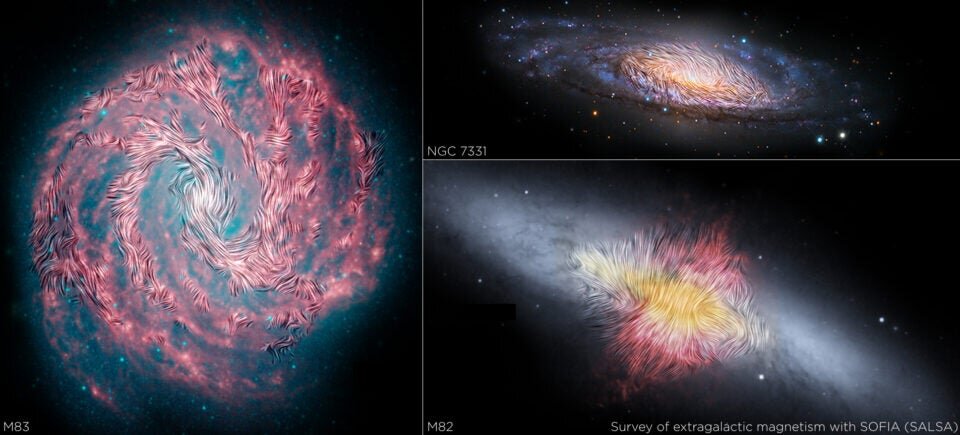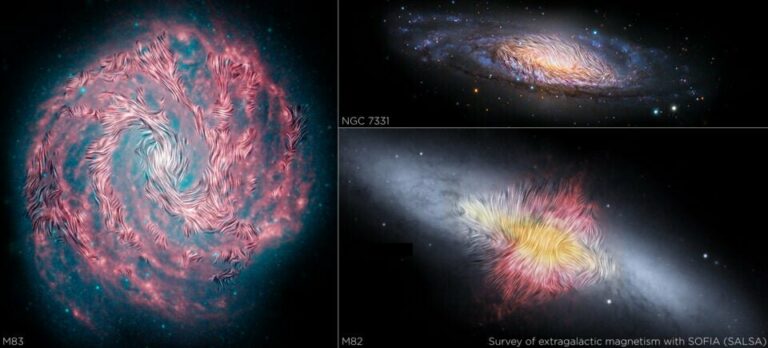Unveiling the Unseen: Identification of Fluctuations in Magnetic Fields Beyond Our Galaxy
Magnetic fields are widespread in the universe, but they present a considerable challenge when it comes to studying them. Unlike other astrophysical data, magnetic fields do not emit or reflect light directly. Instead, researchers have had to find a cosmic equivalent of iron filings – matter within galaxies that is both sensitive to magnetic fields and emits light with characteristics influenced by the structure and intensity of these fields.

In a recent publication in The Astrophysical Journal, a team of astrophysicists from Stanford University focused on studying infrared signals emitted by magnetically aligned dust grains found in the cold and dense clouds of star-forming regions. They compared this to light emitted by cosmic ray electrons, which had been influenced by magnetic fields in warmer and more diffuse matter. Surprisingly, they discovered notable differences in the measured magnetic fields of galaxies.
Enrique Lopez-Rodriguez, a Stanford astrophysicist and member of the Kavli Institute for Particle Acceleration and Cosmology (KIPAC), sheds light on these differences and their potential implications for the growth and evolution of galaxies. Originally from the Canary Islands, Lopez-Rodriguez joined the Bay Area as a scientist working with the Stratospheric Observatory for Infrared Astronomy (SOFIA), a modified Boeing 737 jetliner equipped with instruments capable of operating above most atmospheric dust and water vapor that hinder infrared light. After the conclusion of the SOFIA program in 2022, Lopez-Rodriguez joined Stanford University, where he continues to analyze legacy SOFIA data as one of the principal investigators of SALSA (Survey of extragALactic MagnetiSm with SOFIA).
In the following interview, Lopez-Rodriguez provides insights into their research findings, emphasizing their groundbreaking nature. This study is the first of its kind to compare magnetic fields in different physical environments within galaxies. The researchers examined 15 nearby galaxies using both radio and far-infrared wavelengths. The study involves two principal investigators: Lopez-Rodriguez, responsible for analyzing the infrared data, and Sui Ann Mao from the Max Planck Institute for Radio Astronomy in Germany, who focused on the radio data.
The results of their investigation revealed two distinct magnetic field patterns within the same galaxies. Radio observations indicated highly ordered magnetic fields in the ionized, warm, and diffuse medium located one to two kiloparsecs above the galactic disks under scrutiny (one kiloparsec equals 3,260 light years). On the other hand, the far-infrared light emitted by magnetically aligned dust grains within the midplane of the disks displayed a magnetic field that was nearly twice as chaotic. In summary, regions with more significant star formation exhibited stronger and more turbulent magnetic fields.
What do these chaotic magnetic fields tell us?
The presence of tangled magnetic fields within spiral arms can be attributed to the activity of star formation and the formation of molecular clouds. These tangled fields suggest a high level of turbulence, potentially creating an environment where magnetic fields could be amplified. On the other hand, the areas between the arms of spiral galaxies, as well as the regions above and below the galactic disk, exhibit well-ordered magnetic fields. This orderly arrangement implies that the rotation of the galaxy plays a role in organizing these magnetic fields.
The specific role of magnetic fields in the evolution of galaxies remains largely unknown. However, the far-infrared observations indicate a fundamental connection between magnetic fields and regions of star formation, which is crucial in the process of galaxy formation. The exact nature of this relationship is not yet fully understood, but it is speculated that there might be a feedback loop between the two phenomena.
What’s next? How will you look for the nature of the feedback loop?
As a result of this finding, we are now capable of conducting three-dimensional analyses of magnetic fields in galaxies other than our own. These studies will greatly contribute to our understanding of how magnetic fields influence star formation activity and the evolution of galaxies.
However, to gain deeper insights, we require observations with higher angular resolution to examine star-forming regions more closely. Additionally, studying magnetic fields across different cosmic eras is essential. Fortunately, we are already obtaining such data through the Atacama Large Millimeter/submillimeter Array (ALMA). Furthermore, the upcoming generation of NASA space missions will include advanced far-infrared polarimetric observations, enabling us to study the magnetic fields in a statistical sample of galaxies with even greater precision than before.
Several other Stanford researchers are involved in the study as well. How did you all come together here?
During my time at NASA, I served as an instrument scientist and had the opportunity to fly over 100 missions aboard SOFIA. Each flight was an adventure, although I must admit it became quite a frequent occurrence. In this study, the majority of the observations utilized were taken by myself using HAWC+ (High-resolution Airborne Wideband Camera+), a far-infrared imager and polarimeter. Having extensive experience with the instrument and data processing, I even developed a new observing mode that significantly enhanced sensitivity and reduced observing acquisition time by 300%. Given my specialization in the study of magnetic fields in galaxies, and my existing familiarity with the instrument, data acquisition, and analysis, this project was a perfect fit for me.
After my time with SOFIA, I decided to dedicate myself fully to scientific research, and KIPAC provided an excellent opportunity for me to pursue this path. I was particularly thrilled when I learned that Susan Clark, an Assistant Professor with research goals closely aligned with mine, would also be joining the team at Stanford. Additionally, we have the expertise of Mehrnoosh Tahani, who focuses on studying the magnetic fields in the Milky Way using radio observations, Sergio Martin-Alvarez, who specializes in magneto-hydro-dynamic simulations, and Alex Alejandro S. Borlaff, a visiting NASA postdoctoral fellow from NASA-Ames.
With our diverse range of expertise in magnetism, we have formed a unique and well-positioned team here at Stanford. This enables us to extract the maximum scientific value from the SALSA observations and further our understanding of magnetic fields in galaxies.
Source:PhysORG
Do not forget to share your opinion with us to provide you with the best posts !




0 Comments